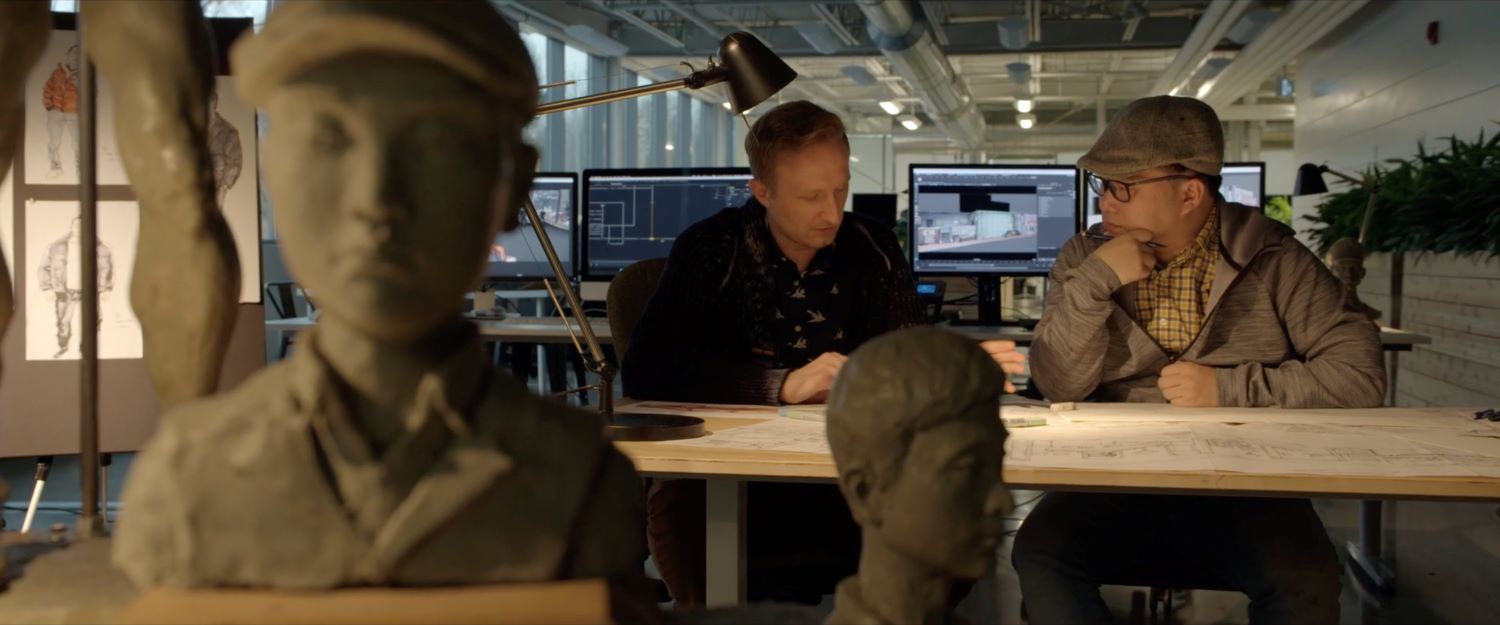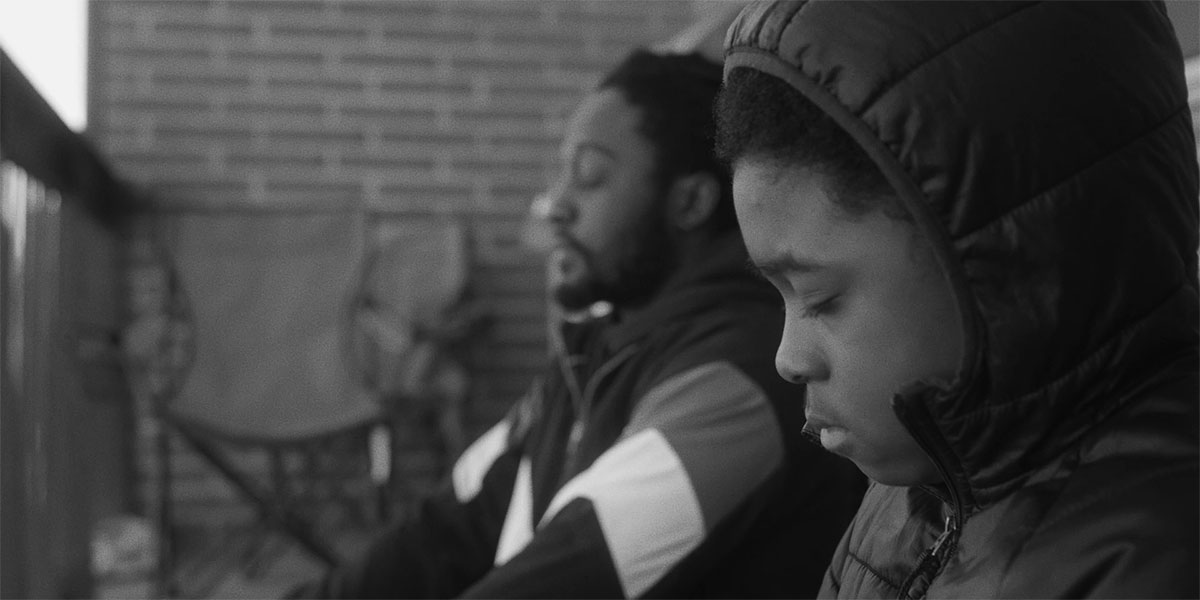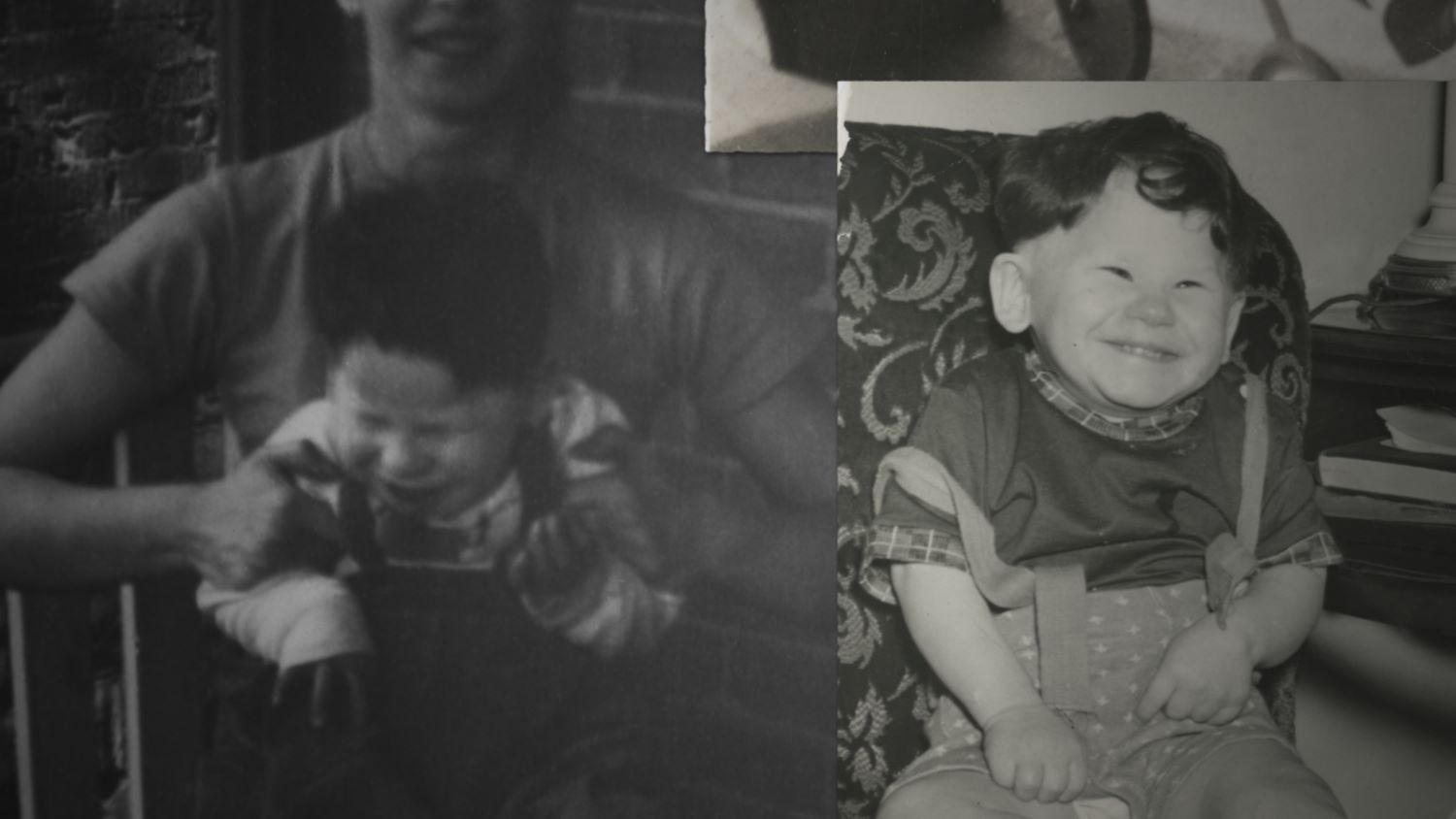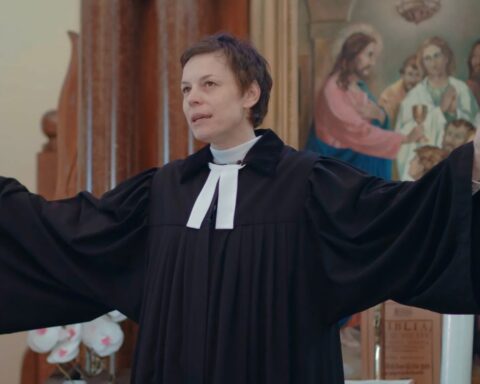An artist’s pen creates an incredible journey in Eternal Spring. The film, which is Canada’s official submission in the Oscar race for Best International Feature, charts the story of artist Daxiong and his artistic awakening after participating in the hijacking of a state TV broadcaster in China amid a growing wave of human rights violations that would soon come crashing down on him and his co-conspirators. The film recreates the riveting hijacking through Daxiong’s unique animation and contextualizes the creative process through interviews and vérité scenes that show the artist’s sparks of animation.
Directed by Jason Loftus and working in a uniquely collaborative process with the artist himself, Eternal Spring animates Daxiong’s effort to bring this story to light. The film draws upon their previous effort collaborating on the video game Shuyan Saga, but illustrates the untold stories housed within our closest friends and colleagues. As the film reconstructs the events of 2002 and retraces the stories of Daxiong’s peers who were either jailed or forced to flee China, Eternal Spring harnesses Daxiong’s craft to tell the story despite the absence of archives, official records, or voices who can tell the tale. As with the recent ani-doc Flee, the film simply couldn’t exist without animation. Loftus’s film offers a powerful look at the artist’s voice using the very elements that let Daxiong defy the state that suppressed him.
Winner of both the Rogers Canadian Audience Award and the overall Audience Award at Hot Docs this year, Eternal Spring is opening in select theatres this week ahead of its Oscar run: the first ever for a Canadian documentary in the category. POV spoke with director Jason Loftus via Zoom shortly after the Oscar announcement to learn more about his collaboration with Daxiong, animating the tale, and bringing a pressing human rights story to light.
POV: Pat Mullen
JL: Jason Loftus
This interview has been edited for brevity and clarity.
POV: In your body of work as a director, writer, and producer, you’ve often looked to China and told stories about Chinese culture that might be of interest in North America. What drives your interest in China?
JL: I’m married to my producing partner, Masha, who is from Northeast China. I also met some great filmmakers who are Chinese-Canadian and helped them with some of their projects and work on the human rights front: you do one of those films and then you build trust in the community. I do think that there is just a cultural fascination and I’m not sure where I picked it up, but, I gravitate towards Eastern cultures and philosophies. That’s how I encountered Falun Gong. Then, whether it was Kung Fu video games or Mandarin language education for preschoolers, my kids are half-Chinese and we want to them to connect with their culture and their language. Perhaps there’s a personal drive that spills into the creative works.

POV: You previously worked with Daxiong on the video game Shuyan Saga. Did you know his backstory at the time?
JL: No, that was the impetus for this film, really. We were making Shuyan Saga, which is a visual novel with some Kung Fu combat experience. For the visual novel component of the game, we used hand drawn art panels and we learned about this artist who was living in New York at the time, originally from China: Daxiong. He’d drawn for Justice League and Star Wars. He’d also worked with Jin Yong (Louis Cha), a leading Kung Fu novelist in China. We brought Daxiong up from New York to Toronto and he was working with us in our studio on this project.
I learned that he came from the same hometown as Masha, who was the daughter of a mid-level government official in China. She didn’t have any connections with Falun Gong or with any dissident or persecuted groups when she was there. Hearing Daxiong’s experience, and what he had been through in her hometown, planted a seed in me for a human rights story.
POV: Why tell this story through animation?
JL: We had this motivation when Daxiong fell into our lap with Shuyan Saga. First of all, he had this amazing artistic ability and he had a personal experience. Oftentimes, documentary has used animation: Flee was a great example last year, but there are other films I’ve enjoyed, like Tower, which used Rotoscope. Waltz with Bashir was a great film a number of years ago, but what excited me was an opportunity to have the animation not simply be an artistic choice by the invisible hand of the director, but to be intimate to the storytelling and part of the journey.
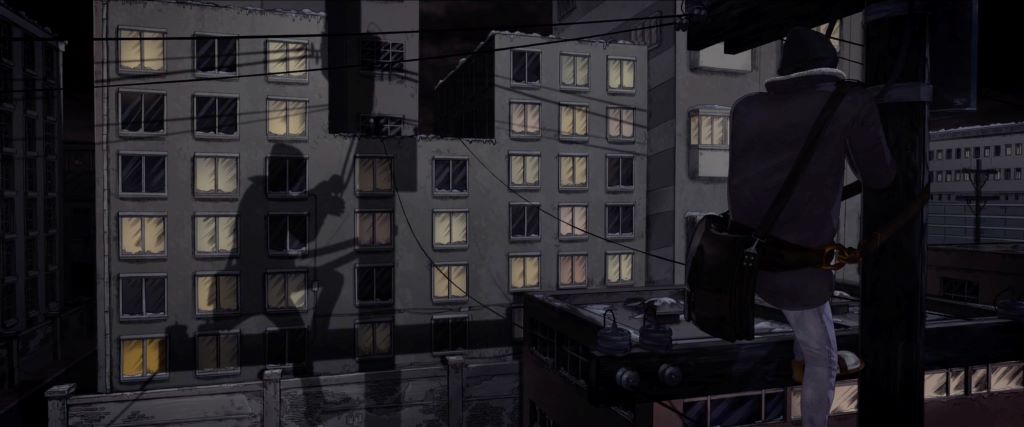
That’s why we have a component of live action in the film. We see the artist: Daxiong is our point of view. We face these events—a dramatic hijacking of the state TV airwaves—and see very real human rights consequences as a result. We see Daxiong processing it and interpreting it through his artwork. Through that, we see how art helps us to gain a new understanding of an event and perhaps provide some catharsis.
POV: Was it difficult telling a story in documentary with animation versus interviews or verité live action?
JL: It created a unique challenge. Typically, when you’re doing animation, you finish your story and cut the audio together. At the very least, you’re going to know exactly what you have with storyboards for every shot. Everything is planned because animation is very time consuming and expensive. With documentaries, we might shoot a hundred hours, then sit in the editing suite and let it emerge. We’re doing both at the same time—cutting a documentary and letting Daxiong’s journey unfold in real time on the camera. At the same time, he’s drawing and we need to animate, so we’re creating scenes before we know how everything fits together in the story. It takes a leap of faith, but only because of that, we were able to get a unique mix and perspective.
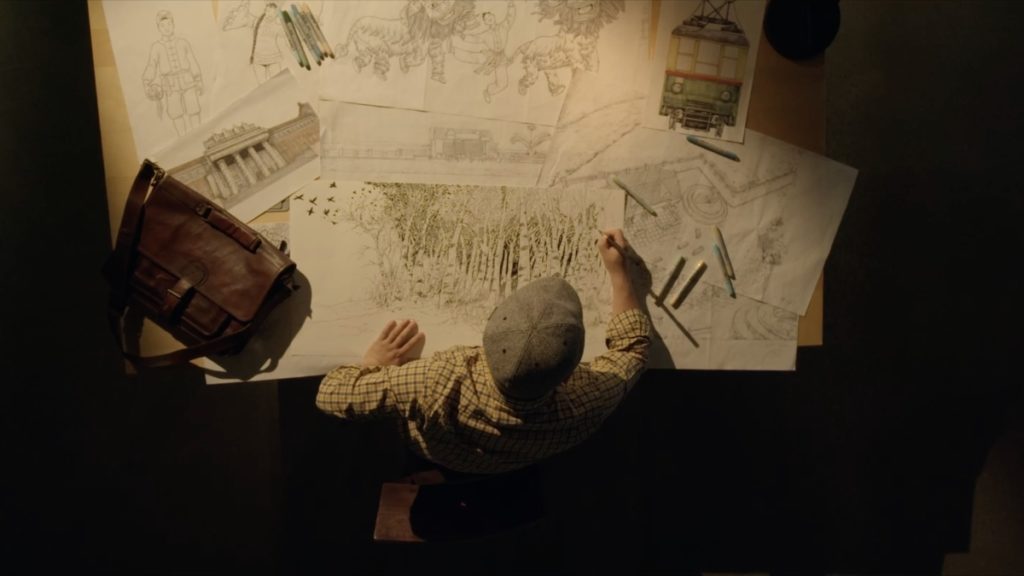
POV: Eternal Spring really feels like a collaboration with Daxiong. What was the workflow?
JL: Having worked together on Shuyan Saga, we knew how we could work. First off, Daxiong’s a 2D illustrator and the film is in 3D. We had to take his evocative, hyper-detailed illustrations and see how we could maintain that aesthetic, but bring them to life with a sense of perspective and a sense of place in a world that is not flat and static. That involved creating a unique production process. Fortunately, we were already involved in animation. We have a small animation studio in here. We had great team members, like David St-Amant on the animation side in Montreal.
We would have Daxiong illustrate storyboards of a scene and then we built those in the 3D software in Maya. Of course, were just building boxes at the time: a building goes here, street characters go there, and we build a rough setup. Then we would use cameras in this space to take images. We would print those out on sheets of paper, and then Daxiong would go to town and draw on top of them.
This allowed us to move the camera in the space and to get that 3D perspective, like in the opening oner that lasts five to six minutes without a cut. You have a sense that you’re in an environment: you’re in his mind and you’re in his space, but it’s all still his pen. Even when you see the taxicab come by in that opening, if you look closer, you can see the markings. It’s actually been hand-coloured by Daxiong.
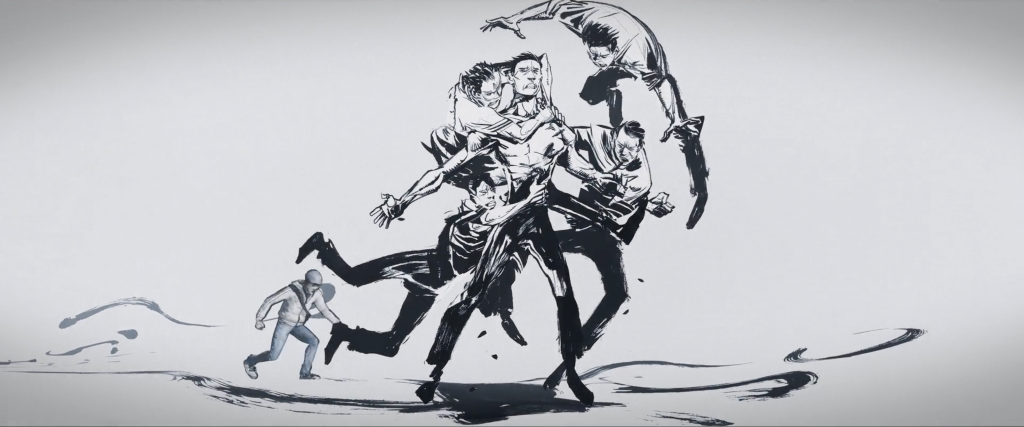
POV: Daxiong is the subject, but he’s also an active creator in the film. What’s it like having someone who is your creative partner and subject, as opposed to, say, a more of a distant subject?
JT: You want his work to be there. It’s not just like someone interpreting what his work is like. You need that proximity, but at the same time, it’s a documentary and it should feel like an objective look at Daxiong and his journey. That worked because Daxiong had built trust.
We took scenes that were central to his experience and his interpretation of events, like the moment where he’s running from his own paintbrush strokes. He was drawing his feelings of what it’s like facing this trauma. We told him “We want it to be authentically you.” Then we’d find a way to interpret it and bring it into the film. We also had a lot of input from Daxiong in terms of how he envisioned it, like in TV hijacking scene where we’re in the living rooms of the different characters Changchun City. We see how Daxiong is looking, not just at what these individuals did, but at what it means for all of the different people who were caught up in this event. We would drop those characters in and develop little backs stories for them, like the, the train conductor who we see at different moments through the film.
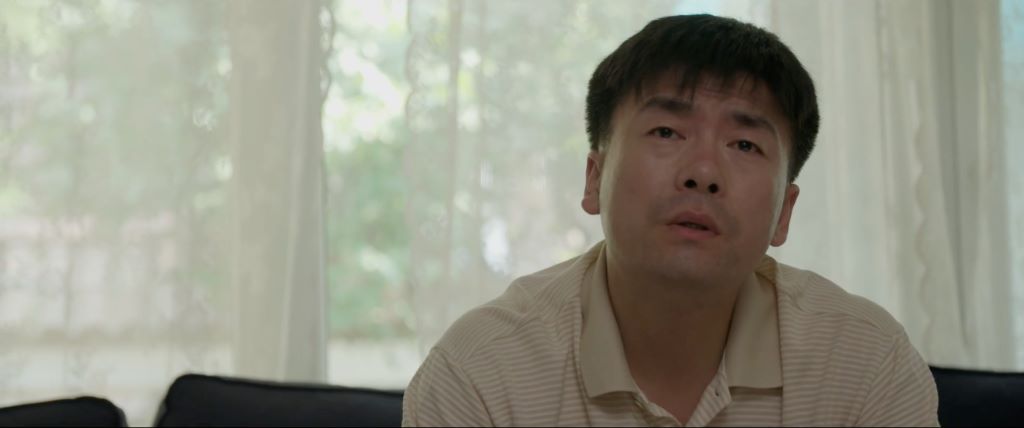
POV: What sort of visual research or story research were you able to do to learn about Changchun?
JL: What you’re seeing is based on what we gathered from interview subjects—we’re pulling from Daxiong without having him direct everything. In other moments, like with Liang and Big Truck and those involved in the hijacking, we would take the lead with Daxiong’s character illustrations and designs, but we would be breaking the story ourselves based on what we found through the interviews. Daxiong’s familiar with the content, he’s been around it, but he hasn’t been the one directing the storytelling. That gives us the distance from the subject, as well as the authentic collaboration that you see on screen.
POV: You encountered some challenges before with Ask No Questions when it comes to trouble with the Chinese government. How did that experience shape your approach to Eternal Spring?
JL: These two films, Eternal Spring and Ask No Questions, were taking place in tandem. This film took us close to six years to produce because we’re a small team and it involved a lot of animation. Ask No Questions happened in the middle of it, and the two stories are related in that one is an investigative journalistic documentary looking at the state media misinformation and trying to ascertain where and how you can find the truth when there is no alternate viewpoint. It’s hard to get to the bottom of things without transparency and counter narratives. Eternal Spring looks at the response. It looks at people on the ground who are facing consequences as a result of the media campaign and human rights abuses. I wanted it to be their story versus outside perspectives with experts and witnesses from the west and analyzing it

The event with Ask No Questions happened in the midst of producing this film. I was aware that there were potential consequences to tackling questions of state censorship. In the interviews for Ask No Questions, we were speaking with journalists in China who said this is a very important story. We’d ask if we could interview them on camera and they’d say something like, “I’m making a book on China and I still need to be able to get inside.” There was a constant “Oh, but” where people were almost flipping a switch. People recognized that there was an important story to be told, but everyone had a reason why it was difficult for them to tell it. That’s true for me too.
POV: How does that impact what you’re making?
JL: The Shuyan Saga game was being published by Tencent, which is a huge media company in China, and in the midst of the launch, it was all over their storefront—they had 200 million users on their Wii game platform at the time—and, all of a sudden, the game disappeared. I reached out to the Tencent rep and we were told they’d already been through two ministries of the government, the censorship office. They said, “They’re all fine with it. It’s not the game: it’s you. It’s the company.” I was asked if we were doing something not aligned with the Chinese government’s direction. My wife’s family members in Changchun were getting phone calls from the public security bureau and being told, “We know what you’re up to overseas.”
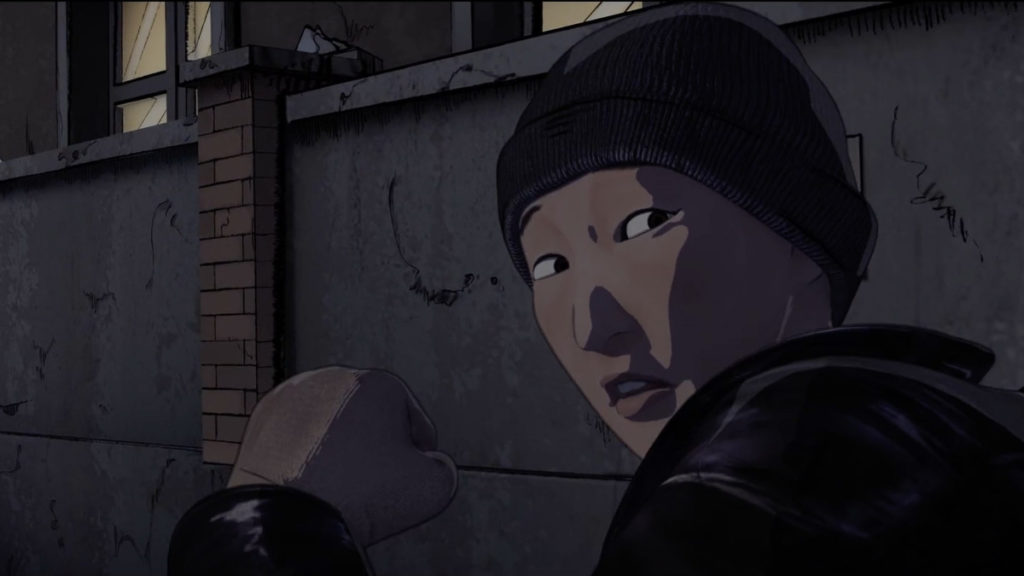
I realize that there’s a potential consequence with the Chinese market, but at the same time, it’s hard to erase your memory when you meet these people. I’ve collaborated with Daxiong and I’ve seen how he went through hell. The people that we met later went through even more hell, and some people lost their lives and were only talking about them. I felt the need to tell this story regardless of the potential consequences. Masha was adamant that this is an important story for Chinese people in general. This is a much broader and more universal issue than the Falun Gong alone, although the Falun Gong human rights situation is severe and worthy of our attention.
POV: It’s nice that the film will have an even larger platform to be able to bring attention to those issues. In terms of the platform, though, we saw a historic set of nominations at the Oscars with Flee nominated in all three categories: documentary, international, and animation. Is Eternal Spring going for all three?
JL: Why not? We’re going to do the best that we can with it. It’s the first time that Canada has chosen an animation, chosen a documentary, and chosen a Mandarin-language film, so we’re in uncharted territory. Obviously, the pan-Canadian jury connected with the film. From another perspective, they’re also looking at which films are positioned to have that success and we’re having a magical festival run. It’s sinking in that we’re representing Canada, so we want to do our best in the categories where the film is eligible.
Eternal Spring opens in select theatres on Sept. 23.




